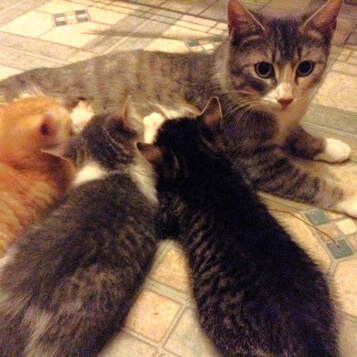Early Age Spay/Neuter
At what age should kittens be spayed or neutered?
Traditionally, veterinarians sterilized kittens around 6 months of age. However, studies have shown that early-age spay/neuter surgery between 8 and 16 weeks of age is safe. Early-age spaying also helps decrease cat overpopulation. A female cat can become pregnant as young as 4 months old and could have her kittens before some veterinarians would even recommend spaying.
Benefits of early-age spay/neuter
Traditionally, veterinarians sterilized kittens around 6 months of age. However, studies have shown that early-age spay/neuter surgery between 8 and 16 weeks of age is safe. Early-age spaying also helps decrease cat overpopulation. A female cat can become pregnant as young as 4 months old and could have her kittens before some veterinarians would even recommend spaying.
Benefits of early-age spay/neuter
- Younger animals recover from surgery more quickly than older ones do; they experience less blood loss and far fewer postoperative complications than adult cats do.
- Eliminates risk of pyometra (infection of the uterus)
- Reduces risk of cervical, uterine, and mammary cancer
- Reduces risk of prostatic enlargement and disease in males
- Reduces the risk of testicular cancer in males
- Reduces urination or territorial spraying
- Reduces aggression and roaming behaviors
- Reduces risk of transmitting FIV and FeLV; reduces males fighting for territory and mates
- Leads to a longer life span
- Helps curb cat overpopulation
 Kittens having kittens!
Kittens having kittens!
Misconceptions about early age spay/neuter
Misconception: It is healthy for a female cat to have a litter of kittens before she is spayed.
Truth: There is no medically proven benefit to allowing females to have a litter of kittens. In fact, female cats who are spayed before their first heat are usually healthier and have a reduced risk of breast and uterine cancer. Additionally, euthanasia is the leading cause of death in cats. Early age spay/neuter will greatly reduce the number of kittens being born and prevent countless cats and kittens from being euthanized at shelters.
Misconception: Kittens cannot get pregnant prior to 6 months of age.
Truth: Kittens can become pregnant as early as 4 months of age and give birth to their first litter when they are only 6 months old. Endorsed by the American Veterinary Medical Association (AVMA), many veterinarians are opting to spay and neuter kittens as early as 2 months old. These young animals recover from surgery more quickly than do older ones, and they experience less blood loss and far fewer postoperative complications than do adult cats.
Misconception: Spaying or neutering a cat early in age results in behavioral issues.
Truth: Spaying or neutering a kitten early in age can actually curb certain behavioral issues such as territorial spraying/urinating and aggression.
For more misconceptions vs. truths about spaying and neutering in general, click here.
Organizations that endorse early-age spay/neuter
For more detailed information, see Chapter 13 of our Guide to Managing Community Cats
Misconception: It is healthy for a female cat to have a litter of kittens before she is spayed.
Truth: There is no medically proven benefit to allowing females to have a litter of kittens. In fact, female cats who are spayed before their first heat are usually healthier and have a reduced risk of breast and uterine cancer. Additionally, euthanasia is the leading cause of death in cats. Early age spay/neuter will greatly reduce the number of kittens being born and prevent countless cats and kittens from being euthanized at shelters.
Misconception: Kittens cannot get pregnant prior to 6 months of age.
Truth: Kittens can become pregnant as early as 4 months of age and give birth to their first litter when they are only 6 months old. Endorsed by the American Veterinary Medical Association (AVMA), many veterinarians are opting to spay and neuter kittens as early as 2 months old. These young animals recover from surgery more quickly than do older ones, and they experience less blood loss and far fewer postoperative complications than do adult cats.
Misconception: Spaying or neutering a cat early in age results in behavioral issues.
Truth: Spaying or neutering a kitten early in age can actually curb certain behavioral issues such as territorial spraying/urinating and aggression.
For more misconceptions vs. truths about spaying and neutering in general, click here.
Organizations that endorse early-age spay/neuter
- American Animal Hospital Association
- American Humane Association
- American Veterinary Medical Association
- American Society for the Prevention of Cruelty to Animals
- Association of Veterinarians for Animal Rights
- Spay USA
For more detailed information, see Chapter 13 of our Guide to Managing Community Cats
References
Banfield Pet Hospital. State of Pet Health 2013 Report. Annual report. Portland, Oregon, 2013. http://www.stateofpethealth.com/Content/pdf/Banfield-State-of-Pet-Health-Report_2013.pdf.
Howe, Lisa M., Margaret R. Slater, Harry W. Boothe, H. Phil Hobson, Theresa W. Fossum, Angela C. Spann, and W. Scott Wilkie. “Long-Term Outcome of Gonadectomy Performed at an Early Age or Traditional Age in Cats.” Journal of the American Veterinary Medical Association 217, no. 11 (December 1, 2000): 1661–65. doi:10.2460/javma.2000.217.1661.
Kustritz, Margaret V. Root. “Early Spay-Neuter: Clinical Considerations.” Clinical Techniques in Small Animal Practice 17, no. 3 (August 2002): 124–28. doi:10.1053/svms.2002.34328.
Nolen, R. Scott. “Study Shines Spotlight on Neutering.” Journal of the American Veterinary Medical Association News, October 16, 2013. https://www.avma.org/news/javmanews/pages/ 131101a.aspx.
Banfield Pet Hospital. State of Pet Health 2013 Report. Annual report. Portland, Oregon, 2013. http://www.stateofpethealth.com/Content/pdf/Banfield-State-of-Pet-Health-Report_2013.pdf.
Howe, Lisa M., Margaret R. Slater, Harry W. Boothe, H. Phil Hobson, Theresa W. Fossum, Angela C. Spann, and W. Scott Wilkie. “Long-Term Outcome of Gonadectomy Performed at an Early Age or Traditional Age in Cats.” Journal of the American Veterinary Medical Association 217, no. 11 (December 1, 2000): 1661–65. doi:10.2460/javma.2000.217.1661.
Kustritz, Margaret V. Root. “Early Spay-Neuter: Clinical Considerations.” Clinical Techniques in Small Animal Practice 17, no. 3 (August 2002): 124–28. doi:10.1053/svms.2002.34328.
Nolen, R. Scott. “Study Shines Spotlight on Neutering.” Journal of the American Veterinary Medical Association News, October 16, 2013. https://www.avma.org/news/javmanews/pages/ 131101a.aspx.
